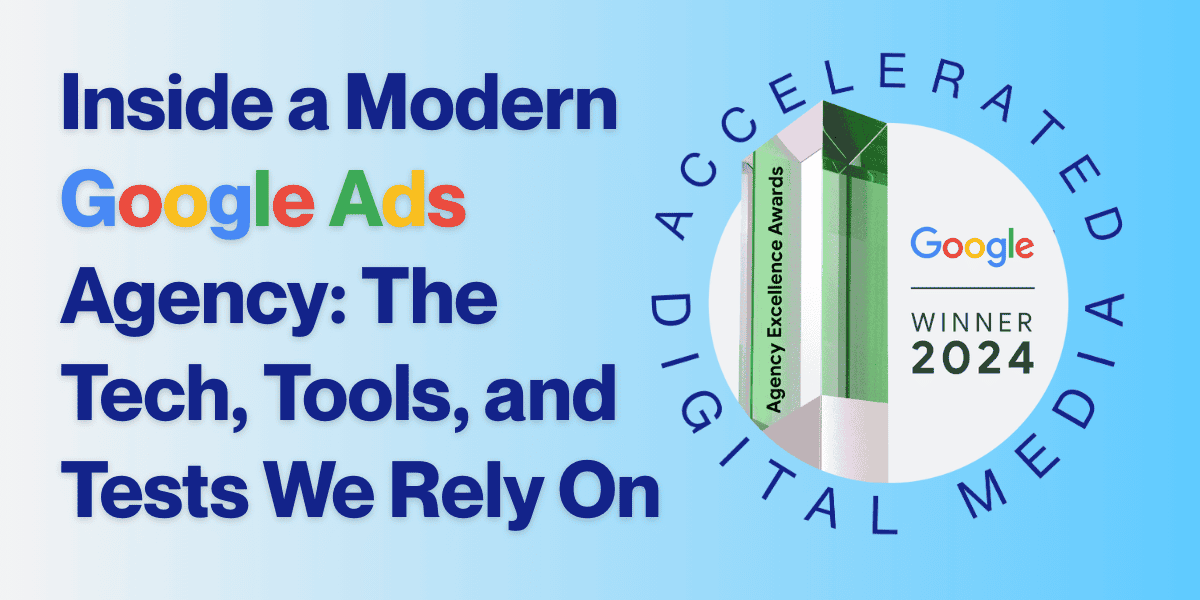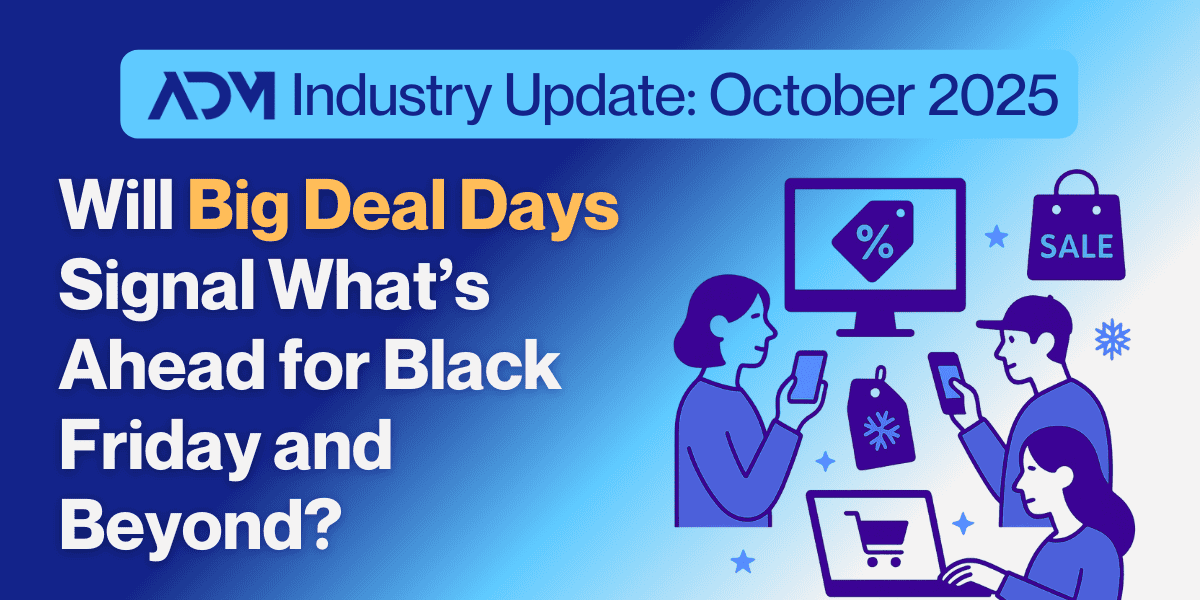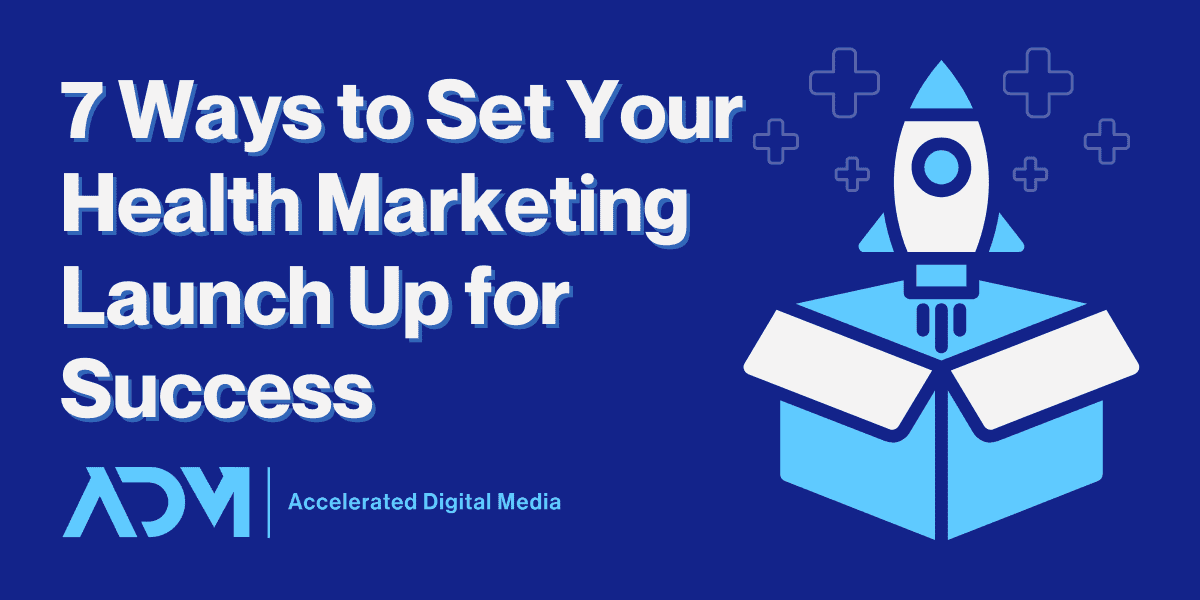Google Ads is a titan in digital marketing because it’s accessible to all businesses. Though anyone can open an account and set up simple campaigns to advertise their business, the vast landscape of Google Ads agencies exists to help brands conquer its numerous intricacies and intensely competitive auctions. A truly great Google Ads agency will always be at the forefront of innovation, leveraging advanced tools and carefully-planned strategies so its clients can stand out and grow.
As a Google Premier Partner and a Google Ads Agency Excellence Award winner, we like to think of ourselves as one of those forward-thinking agencies. So in this blog, we want to pull back the curtain a bit and give a glimpse of how agencies like ours approach Google Ads, exploring the processes, tools, and technologies we use to keep clients ahead in the competitive landscape.
Getting the Most Out of New, Advanced Google Ads Tools
Google Ads has evolved dramatically from the days of straightforward Search and Display campaigns. Agencies today have so many more tools at their disposal. Those tools are continually updated or, at times, replaced by better ones. A quality Google Ads agency will not just stay up-to-date on the advertising tech that will help their clients, but will aim to master it quickly and develop their own unique strategies for deploying it.
Maximizing Performance Max
We write about Performance Max campaigns very often because they’re that important—and because there’s a lot to say about them. They’re an AI-powered comprehensive campaign type that allows advertisers to reach audiences across all Google channels, including Search, Shopping, Video, and even Maps and Gmail. Just because they rely on advanced algorithms—and often produce excellent results—doesn’t mean they’re “set it and forget it” campaigns, however. Smart Google Ads agencies have learned to tailor these campaigns to get even more out of them.
At ADM, we started this learning process early and were recognized on a Google earnings call for our early adoption and success. In the years since these campaigns launched, we’ve continued to test Performance Max strategies while integrating Google’s many feature updates in order to develop our unique approach.
Performance Max For Shopping and eCommerce
Performance Max is particularly effective for Shopping placements, and for many brands it has replaced traditional Google Shopping campaigns. In recent years, Google has added more Shopping ad inventory and increased their prominence on the search engine results page (SERP), which further increases the importance and opportunity that Performance Max can present for eCommerce brands. To make sure our eCommerce clients are positioned to grow revenue through these placements, there are a few things we prioritize:
- Exacting Feeds and Feed Management: Because Shopping ads are dynamically created, your listing is only as good as the feed it draws from. We partner with Feedonomics to make sure our clients’ feeds are robust and up-to-date to ensure Performance Max campaigns are equipped to deliver better Shopping ads.
- Consistent Shopping Tests: Stagnation is never acceptable, so to avoid that we continually test our clients’ Shopping campaigns for continued improvement. We test one variable at a time, like titles, images, or title order, using pre/post comparisons, focusing on improving CTR, CVR, and CPA. Sometimes small tweaks, like updated descriptors or lifestyle imagery, can drive major improvements.
Non-Shopping Applications
While Performance Max gets a lot of attention for its Shopping applications, its versatility across mediums is its biggest draw. That means Performance Max isn’t just for eCommerce: it can offer various benefits, including lead generation and brand awareness. As an advanced Google Ads agency, we’ve worked to find what these campaigns can do best for clients that can’t access Shopping placements, including our large portfolio of healthcare and digital health clients.
- Performance Max thrives when used strategically: These campaigns can perform better not just as a catch-all campaign. By testing specific concepts or verticals within Performance Max can drive efficient, incremental growth without cannibalizing existing efforts. Success comes from careful targeting, strong creative, and continuous optimization.
- Better placement insights can drive campaign decisions: Performance Max campaigns can sometimes seem opaque because so much decision-making is done by AI. Google has added some additional insights to make these campaigns more transparent, but ADM sometimes supplements them with custom scripts to better understand things like placements and performance.
Smarter Video Campaigns: Demand Gen and Video Reach
Performance Max isn’t the only smart campaign strategy that has changed how agencies approach Google Ads. Awareness and video advertising campaigns have received similar treatment: formats like Demand Gen and Video Reach utilize AI-driven targeting to reach users across a number of placements, particularly in emerging mediums like YouTube Shorts. ADM has also placed special emphasis on these campaigns, and our work resulted in us being one of just 9 agencies in North America given a Google Agency Excellence Award in 2024.
Our Video Campaign Strategy:
- Targeted Audience Segmentation: We use AI to segment audiences based on behavior and preferences, delivering personalized video content that resonates with viewers.
- Cross-Platform Consistency: By maintaining consistent messaging across platforms, we ensure that video campaigns reinforce brand identity and drive engagement.
Demand Gen campaigns are designed to complement top-of-funnel marketing efforts, leveraging AI to increase visibility on Google’s Discover Network and YouTube Shorts. This approach allows us to create engaging video content that resonates with target audiences, driving both paid and organic conversions.
Refreshed Keyword Match Type Functionality
Google’s keyword match types have evolved substantially over time thanks to Google’s algorithms, and smart agencies have adapted how they use them as a result. Broad Match has become more sophisticated, leveraging AI to align ads with user intent rather than just specific keywords. This shift allows Broad Match to serve ads for a wider array of queries, enhancing reach and conversion potential. Meanwhile, Exact Match has evolved to now cover close variants like misspellings—much like Phrase Match used to.
Effective Use of AI-Powered Keywords:
- Leverage Broad Match: We use Broad Match in separate campaigns with Phrase Match variants as negatives to discover new keywords and themes.
- Segment Match Types: We maintain a strategic balance across match types to optimize both volume and efficiency.
- Customize Strategies: We tailor match type programs based on performance data to meet specific client goals
How Google Ads Agencies Measure Success
Measurement and reporting are utterly vital to Google Ads growth. To truly understand your marketing, you need more than just in-platform readouts. That starts with thorough knowledge of how to build an accurate, robust Google Analytics account. But because Google can only track so much, it also includes the use of outside attribution platforms that can measure marketing impact across numerous customer touchpoints, both online and off.
Analytics Audits
We begin all client relationships with a thorough audit to understand both their marketing strategies and how well they’re tracking data. These audits help us identify areas for improvement and optimize strategies to align with business goals. ADM’s approach to Google Analytics audits is centered on ensuring the accuracy and reliability of historical data, which is crucial for informed strategic decisions. We tailor each audit to align with the client’s unique business goals, assessing whether the current setup meets industry standards and tracks actionable data. Our audits involve:
- Comprehensive Evaluation: We examine configuration settings, tag implementations, and channel attribution pipelines to identify discrepancies and optimize data collection.
- Customized Recommendations: Based on audit findings, we provide tailored recommendations and implement changes to enhance data accuracy and decision-making
GA4 Setup and Tracking Implementation
Google Analytics 4 (GA4) is an essential tool for tracking and analyzing campaign performance. At ADM, we utilize GA4 to gain insights into user behavior and engagement, allowing us to make data-driven decisions that enhance campaign effectiveness. GA4’s advanced features provide a comprehensive view of the customer journey, enabling us to optimize strategies based on real-time data.
Our Use of GA4:
- Cross-Platform Analysis: We use GA4 to track user interactions across web and app platforms, providing a holistic view of customer behavior.
- Predictive Analytics: By leveraging GA4’s predictive metrics, we anticipate trends and adjust strategies to maximize ROI.
Effective implementation and tracking are crucial for accurate measurement. We use Google Tag Manager to streamline the process, ensuring that all campaign elements are tracked and reported accurately. This tool allows us to manage tags efficiently, reducing the complexity of tracking multiple campaigns and ensuring that data is collected consistently.
Third Party Measurement and Attribution Tools
In addition to GA4, we rely on third-party measurement and attribution tools to provide a holistic view of campaign performance. These tools allow us to track cross-channel interactions and understand how different marketing efforts contribute to overall success. By integrating data from various sources, we demonstrate the impact of our strategies and optimize for maximum ROI.
Understanding the interplay between different channels is vital for optimizing marketing strategies. By analyzing data from various sources, we demonstrate how channels work together to drive conversions and enhance ROI. This approach allows us to create integrated campaigns that leverage the strengths of each channel, ensuring a cohesive and effective marketing strategy. A lot of this work relies on finding the right tool for different applications.
- Incrementality Testing: We use Measured for A/B tests to determine the true lift of media channels, ensuring clarity on each channel’s incremental impact.
- Multi-Touch Analysis: Rockerbox employs Multi-Touch Attribution and post-purchase survey data to offer a holistic view of consumer behavior across channels.
- Tailored Attribution Models: We help clients choose models that align with their business goals, whether it’s Last Click, First Click, or Linear, to optimize budget allocation and maximize ROI
Techniques and Tests
While there are always new ads and campaigns to buld—and new clients to onboard—at ADM, we make sure to devote a healthy amount of our Google Ads management time to finding new growth opportunities for our clients. This means we’re constantly testing different strategies to try to solve client problems. We use those learnings to inform decisions across our client portfolio.
Keyword Testing
Keyword testing is a fundamental aspect of our optimization process, allowing us to refine strategies and improve ad relevance. By experimenting with different keyword match types and variations, we identify the most effective combinations for driving engagement. This iterative process helps us stay ahead of changes in user behavior and search trends, ensuring that our campaigns remain competitive.
Our Keyword Testing Approach:
- A/B Testing: We use A/B testing to compare the performance of different keyword match types and identify the most effective strategies.
- Incrementality Analysis: By assessing the incremental value of keyword changes, we optimize budget allocation and maximize ROI.
Creative Testing
Creative testing involves evaluating different ad elements, such as headlines, descriptions, and visuals, to determine what resonates best with audiences. This iterative process helps us refine ad copy and creative assets to maximize impact. By conducting A/B tests and analyzing performance data, we optimize creative elements to enhance engagement and conversion rates.
Our Creative Testing Techniques:
- Ad Copy Variations: We test different headlines and descriptions to identify the most compelling messaging.
- Visual Asset Evaluation: Experimenting with various image and video formats helps determine the most engaging creative.
Incrementality Tests
Incrementality tests are crucial for understanding the true impact of our campaigns on business outcomes. By isolating the effects of our advertising efforts, we allocate budgets more efficiently and maximize return on investment. This approach allows us to identify the incremental value of each campaign, ensuring that resources are focused on the most effective strategies.
Continually Striving to be the Best Google Ads Agency
Digital marketing is highly-competitive, both for advertisers and the agencies that support them. Standing out among the crowd takes commitment, innovation, and enormous attention to detail. Inside a modern Google Ads agency like ours, there’s also an emphasis on a strong team culture that prioritizes client success and mutual growth. If you’re looking to reach ambitious growth goals through a revamped Google Ads strategy, contact the team at Accelerated Digital Media to see if we’re the right fit.




